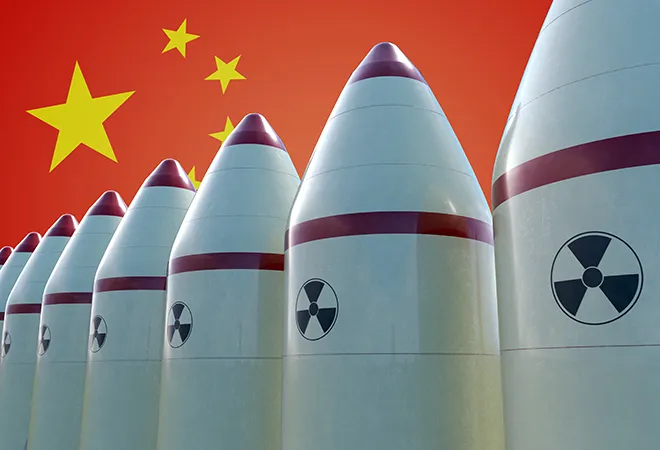-
CENTRES
Progammes & Centres
Location

This is the 100th article in the series The China Chronicles.
Read the articles here.
China’s nuclear weapons program began around 1955, with significant assistance from the erstwhile Soviet Union in order to gain technical and operational expertise. China conducted its first successful nuclear weapons test in October 1964 and has gone on to become a key stakeholder in the nuclear world order. At present, China is estimated to have 320 nuclear warheads and is in the midst of an extensive modernisation of the country’s nuclear arsenal as a part of a comprehensive military modernisation effort. China’s military and nuclear modernisation strategy has raised concerns among countries party to the nuclear non-proliferation regime and has specifically drawn criticism on the potential escalatory nature from the United States. Overall, there is considerable concern surrounding the modernisation plan and the lack of transparency in the intentions raising significant concern. Given the rising tensions amongst several nuclear weapons states, China’s push for a more modern nuclear weapons arsenal as well as nuclear posture does not bode well for the nuclear non-proliferation regime, with the potential for a more aggressive nuclear arms race in the future.
"China’s military and nuclear modernisation strategy has raised concerns among countries party to the nuclear non-proliferation regime and has specifically drawn criticism on the potential escalatory nature from the United States.
Over the years, China has published a few ‘white papers’ on the country’s defence and military strategy and infrastructure. However, they have provided little insight into the workings of the country’s defence system. The most recent ‘Defence White Paper’ published by China in 2019 has been the most extensive document to provide a look into the modernisation plans, which the previous iterations of the document had failed to do. The document reinforces China’s commitment to the nuclear policy of ‘No First Use’ (NFU). It also mentions that China is not engaged in “any nuclear arms race with any other country and keeps its nuclear capabilities at the minimum level required for national security.”
However, the international response, specifically from the United States, to the document indicates serious apprehension and concern around China’s commitment to the intentions of NFU and avoiding any nuclear arms race. The United States has reiterated the need for China to be involved in any future nuclear non-proliferation agreement with Russia and the US. Recently, the US stressed the importance of involving China in the discussions with Russia on the future of New START. The 2019 white paper also discusses the intent to enhance People’s Liberation Army Rocket Force’s (PLARF) capabilities of nuclear deterrence and counterattack (through a stronger and modernised rocket force). China has asserted that their intention with the modernisation plans is not to push for a nuclear arms race with key actors in the nuclear world order. However, the extensive focus on modernisation capabilities in the document does little to assuage the concerns of the nuclear non-proliferation regime.
"The 2019 white paper also discusses the intent to enhance People’s Liberation Army Rocket Force’s (PLARF) capabilities of nuclear deterrence and counterattack (through a stronger and modernised rocket force)."
The 2018 United States’ Nuclear Posture Review (NPR) also sees the future of the nuclear world order from Washington’s perspective. The NPR looks at the China angle and discusses the overarching belief that China’s military posture is increasingly assertive and argues that “direct military conflict between China and the United States would have the potential for nuclear escalation.” Given the escalatory nature of tensions between the two nuclear powers, it becomes necessary to question the overemphasis on the efficacy of ‘deterrence’ as a justification by nuclear weapons states.
As China’s nuclear stockpile continues to grow and modernise, Hans Kristensen and Matt Korda assess the nuclear modernisation program in its entirely in their paper titled 'Chinese nuclear forces, 2019.’ According to their research, China continues to develop new capabilities such as a new dual-capable intermediate-range mobile ballistic missile and modernise its nuclear Medium-Range Ballistic Missile (MRBM), road-mobile launcher and an air-launched dual-capable ballistic missile. The 2020 SIPRI yearbook also stresses concerns around China’s lack of transparency and highlights China’s plans to modernise its nuclear arsenal with the development of a nuclear-capable strategic bomber to complete the nuclear triad where weapons can be delivered by land, air or sea.
China’s nuclear force modernisation also impacts its defence relations with India. China’s extensive military reforms have placed considerable pressure on Indian authorities to ramp up their military infrastructure and improve the country’s defence capabilities. According to a paper published recently by Yang Chengjun, China has deployed an early missile warning system which allows the PLARF to detect nuclear missiles launched at mainland China and counterattack using their own nuclear weapons within minutes. Kristensen and Korda’s analysis on ‘Indian nuclear forces, 2020’ also posits a potential shift in India’s nuclear strategy, which has primarily focused on Pakistan, towards an emphasis on China. As seen with the new Agni missiles with their range to strike Beijing, India’s current and future nuclear strategy decisions do place importance on China’s growing nuclear capabilities and modernisation.
"China’s nuclear force modernisation also impacts its defence relations with India. China’s extensive military reforms have placed considerable pressure on Indian authorities to ramp up their military infrastructure and improve the country’s defence capabilities."
China’s modernisation efforts for its nuclear arsenal have added to the destabilisation of an already weak global nuclear order. Although, there has been an overall reduction in nuclear warheads of nuclear weapons states, the non-proliferation regime has been consistently hit with setbacks in international agreements and bilateral co-operation. With the collapse of several international agreements that pushed for non-proliferation, it becomes evident that the lack of engagement between nuclear weapons states is dangerous and it is necessary for greater engagement with instruments that curb nuclear arms ambitions and promote non-proliferation. With China’s increasingly assertive military strategy, the risk levels have also risen. Although China has rejected any interest in a multilateral arms reduction agreement with Russia and United States, there is a need to push for a strategic dialogue that involves China with the international nuclear community. Given the rising regional animosity in South Asia and tensions between China and the US, the international community cannot ignore the adverse effects of a more aggressive arms race. Therefore, any attempt to move towards non-proliferation requires China’s involvement in measures to pursue nuclear disarmament.
The views expressed above belong to the author(s). ORF research and analyses now available on Telegram! Click here to access our curated content — blogs, longforms and interviews.

Pulkit Mohan is the Head of Forums at ORF. She is responsible for the ideation curation and execution of ORFs flagship conferences. Her research focuses include ...
Read More +